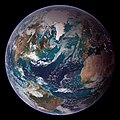Файл:Blue Marble Western Hemisphere.jpg

Къаддæргонды ас: 600 × 600 пикселы Другие разрешения: 240 × 240 пикселы | 480 × 480 пикселы | 768 × 768 пикселы | 1024 × 1024 пикселы | 2048 × 2048 пикселы | 3718 × 3718 пикселы.
Оригиналы файл (3718 × 3718 пикселы, файлы уæз: 2,65 МБ, MIME тип: image/jpeg)
Файлы истори
Ныххæц датæ/рæстæг-ыл, цæмæй фенай еуæд куыд фæзындис.
| Датæ/рæстæг | Къаддæргонд | Барæнтæ | Архайæг | Фиппаинаг | |
|---|---|---|---|---|---|
| нырыккон | 11:59, 5 мартъийы 2013 |  | 3718 × 3718 (2,65 МБ) | Szczureq | User created page with UploadWizard |
Файлæй архайд
Ацы файлæй пайда кæны иу фарс:
Ацы файлæй куыд пайда кæнынц
Данный файл используется в следующих вики:
- Использование в alt.wikipedia.org
- Использование в av.wikipedia.org
- Использование в bn.wikipedia.org
- Использование в ca.wikipedia.org
- Использование в ckb.wikipedia.org
- Использование в cv.wikipedia.org
- Использование в da.wikipedia.org
- Использование в el.wikipedia.org
- Использование в en.wikipedia.org
- Ecological footprint
- User:P3Y229/sandbox
- Wikipedia:Meetup/NYC/AfroCrowd/Home
- Wikipedia:Wikipedia Signpost/2018-10-28/Gallery
- Wikipedia:Wikipedia Signpost/Single/2018-10-28
- User:Lngnbchr/TWA/Earth/2
- User:Saoirse mck/TWA/Earth/2
- User:Northamerica1000/Topics
- User:Nikola Tesla edit/TWA/Earth/2
- User:SDL87/TWA/Earth/2
- User:Mpurcell1/TWA/Earth/2
- User:Mpbrooke/TWA/Earth/2
- User:Tlonedyr
- User:JD Cornbread/TWA/Earth/2
- Использование в en.wikibooks.org
- Использование в en.wikiquote.org
- Использование в en.wiktionary.org
- Использование в es.wikipedia.org
- Использование в eu.wikipedia.org
- Использование в fa.wikipedia.org
- Использование в fi.wikipedia.org
- Использование в fr.wikipedia.org
- Использование в he.wikipedia.org
- Использование в hu.wikipedia.org
- Использование в hy.wikipedia.org
- Использование в id.wikipedia.org
- Использование в it.wiktionary.org
- Использование в ja.wikipedia.org
- Использование в kk.wikipedia.org
- Использование в ko.wikipedia.org
Просмотреть глобальное использование этого файла.



